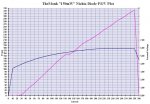GooeyGus: Agreed, we can not expect twice the rated power - especially after plastic lens - out of every diode.
The manufacturing processes for 405nm's produce diodes, that are WAY too inconsistent at this moment. 405nm diodes vary all over the place. Even the good ones!
Just wait, till you see the PIV data i collected of 56+ (soon 78) GGW diodes. Those are diodes, that were first decided to match the ratings by the diode manufacturer, and later even by the manufacturer of the drives....
Now, since those GGWs are reject sleds, some of the diodes MIGHT have had so low an efficiency, that just this was the reason the sled failed QC! I've seen MANY like that! (Too many = -$$$... :cryyy

But i've taken all of this into account, when making the decisions i posted here.
While it is true, that we can not expect double the rated power out of EVERY diode, we CAN expect it out of MOST of them, without our expectations being exaggerated...
And by "most of them", i mean "most out of each model". There are HUGE variations between individual diodes of the same model! BUT while the manufacturers can't make them any better yet, they do test them after they are finished, and weed out the ones that don't match the specs, and only leave the ones, that fall within a datasheet's ratings, and can deliver the required powers with a long enough life....
These variations are the precise reason i ordered more than one - to exclude the possibility of the one being a random freak or a random weakling....
But the results we have collected so far are consistent. Consistent with PHRs, that is, or maybe 4x's....
Also, i have taken the losses in the lenses into account, when making a decision about the diode's most likelly power rating (40-60mW). I have a "Nichia lens" made to Nichia's specs for 405nm diodes, which has the lowest possible (known) losses, which i've been using to test the various diode's "raw power" and calculate their relative wavelengths for over 9 months by now.
Otherwise, is it wrong of me to expect the 150mW Nichia's to be better than the 100mW Nichia? If nothing else, they should at the very least be just as good during the PIV plot, and at what they can take.... If they were at least 100mW CW diodes, i would not even know yet, that there is something wrong with them!
But they have kinks - many even below their rated CW power (raw power, not after plastics) - while the 100mW Nichia doesn't have them at all, and they die at powers the 100mW Nichia survives easily...
So what am i supposed to think?
Anyway, i have typed TheMonk's data in, extrapolated the missing datapoints, and plotted it, attached are the results..
I'll add it to the other two. Then i'll ask Steve, if it's OK if i plot my third diode, or if i should return it untouched...
Then we will have data for three, or maybe even four diodes, which completelly excludes ANY possibility, that we were just "unlucky"... Altho for me, the two were already telling enough.
After testing over 150 diodes of five (or six - if these are different from PHRs or 4x's) different models, i know what to expect from them...
Otherwise, i've made an incorrect statement in this thread. I said that these diodes would only last 1-20 hours at 150mW.. That's not true.... They would have lived a bit longer at 150mW raw power. I was thinking of power after an AixiZ acrylic lens. But their life at 150mW raw power would still not be very long. Maybe long enough for pointer use with the very good ones...
But this doesn't influence my power rating assesments. Because the same is true for PHRs.... At 130mW after plastics their raw power is around 150mW depending on wavelength.
I'll do a lifetime test on my cycler circuit this week, to see if they are closer to PHRs or 4x's....
P.S.
GooeyGus, it was you, who showed us, how far we can (and can not) push GGWs with your endless murders of bizzarelly expensive diodes. You've done EVERYONE here on LPF a GREAT favor with that - the things you've thaught us were invaluable, and it cost you way over a thousand dollars! I'll be forever in your debt for that! :bowdown:
Without your data, i'd never dare risk setting a diode that cost me $350 to get (a diode, which you extracted and sent me - THANK YOU!) to a power of 193mW after a plastic lens....
People, who are now complaining to Steve about one $50 diode should keep this in mind! GooeyGus lost as much money on his GGW experiments, as i did on my lens tests, but without that we would have no clue what to expect from GGWs until they became cheaper...
P.P.S.
TheMonk: Thank you for your data, i didn't know about your thread unfortunatelly, or it might have saved me some money...
But you were correct in expecting an 8x-like diode from these... It should have been... That's the whole point here.




